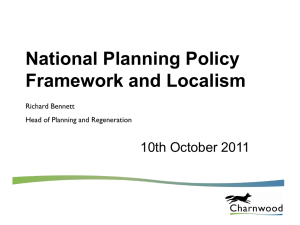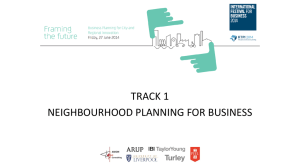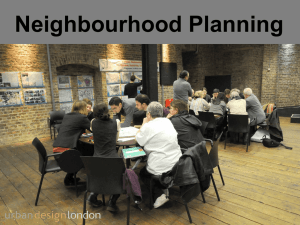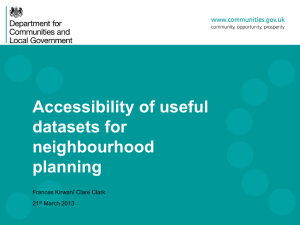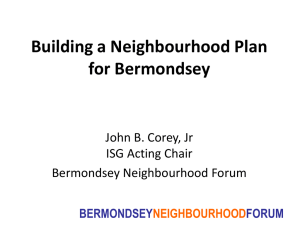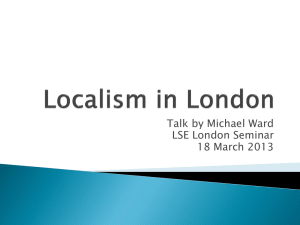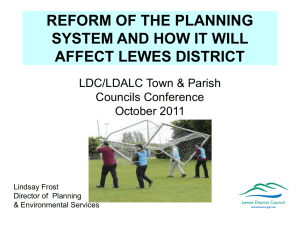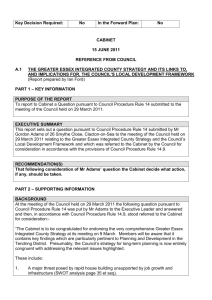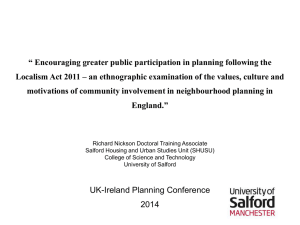Department for Communities and Local Government
advertisement
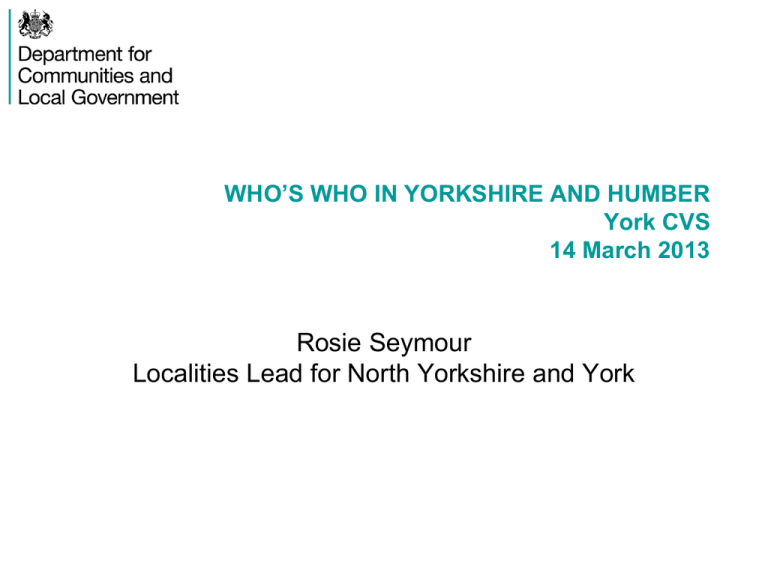
WHO’S WHO IN YORKSHIRE AND HUMBER York CVS 14 March 2013 Rosie Seymour Localities Lead for North Yorkshire and York Localities Manager role Work with local areas to: • Develop practical relationships to ensure that local areas have a way to ensure honest and regular dialogue, support and signposting where necessary to central Government. And ensure that DCLG has the intelligence and level of engagement with local areas that we need to inform policy. • The role also helps us shape things like Ministerial visits and parliamentary responses, and enables us to explain policy and opportunities to local areas. A whirlwind of change Budget Reductions LEPs, local growth funding & City Deals Troubled Families Health & Wellbeing Academies & Free Schools Welfare Reform Business Rates Retention Localism, Localism, Localism Local Government Response Mix of measures: - making efficiencies - organisation change - streamlining back office - outsourcing - service transformation Prioritising adult social care and children’s services Reducing (disproportionately) planning, housing and central services Cutting discretionary functions 10% •Mike to insert chart 0% Adult social care -10% -20% Childrens social care Highw ays Environmental 2011-12 Housing 2012-13 Cultural -30% Planning -40% -50% Central services Total Where next: through to April 2013 What Next? – A New Financial Relationship Unhypothecated grant 70,000,000 Local share Sales fees and charges 60,000,000 Council tax 50,000,000 40,000,000 30,000,000 Locally based funding – c. 60% to c.80% 20,000,000 10,000,000 Before After 2012-13 Formula Grant funding and if the rate retention model already in place (including police) Fiscal consolidation and Spending Round 2013 • Moody’s downgrading of the UK economy. • Taking longer to climb out of debt with slow GDP growth • Continuing reductions in public sector spending since 2010 “emergency” budget Autumn Statement set a spending envelope for 2015-16: •total spending will fall at same rate as in SR10. •Within that, capital spending will grow in line with inflation from 2014-15 onwards. Will look for total additional savings of at least £10 billion. 26 June announcement. The Strategic Context for communities Huge wealth of knowledge, experience and expertise in local communities that is not being tapped into. Local communities know what’s best for them and their community, it makes sense to use that knowledge, experience and expertise for the community good Financial climate is difficult and will remain so for the next few years Innovation is needed to do more and better with less Our role as central government is an enabler: enthusing, informing, networking and supporting communities Localism Act What difference does it make? Autonomy for local government Powers to Communities Right to Bid (Assets of community value) Right to Challenge Right to Build Neighbourhood Planning Governance and Accountability Freedom over governance structures Transparency Freedom to act (General Power of Competence) Greater control over finance Freedoms for Cities Neighbourhood Planning What does it do? Neighbourhood plans help local communities to have a much greater say in how the areas that they live and work in develop and grow. Neighbourhood planning gives the right to parish councils or designated neighbourhood forums to produce a Neighbourhood Plan or Neighbourhood Development Order or both. How? Once a Neighbourhood Plan is brought into force after a referendum it becomes part of the statutory development plan for the local area and is part of the basis for deciding planning applications in that area. A Neighbourhood Development Order will automatically grant planning permission for development proposals which comply with the order. Neighbourhood Planning Myth busting: Neighbourhood planning is not..... • • • • A way to stop development happening Only for rural areas and parish councils A system which requires the production of very comprehensive technical plans – neighbourhood plans can be as concise or as comprehensive as communities want and address just a few simple concerns or a range of very complex planning issues A legal requirement – it is a right which communities can choose to exercise Neighbourhood planning is..... • • • An opportunity to shape the development of a local area by producing a plan with real statutory weight An opportunity to turn ambitions into reality through a development order An opportunity to build new and improve existing partnerships Neighbourhood Community Budgets – supporting areas to redesign services Type Parish Councils Neighbourhood Ilfracombe; Haverhill; Cowgate, Kenton Bar & Montague (Newcastle) White City; Local Authorities Norbiton; Sherwood (Tunbridge Wells); Shard End (Birmingham); VCS Themes Queens Park; Little Horton (Bradford); Poplar (Tower Hamlets); Castle Vale (Birmingham); Balsall Heath (Birmingham) Troubled families; Health & well being; Community assets; Housing; Worklessness; Social enterprise; Local Economic Growth; Anti social behaviour; Gang violence; Questions and discussion rosie.seymour@communities.gsi.gov.uk 0303 444 3342

